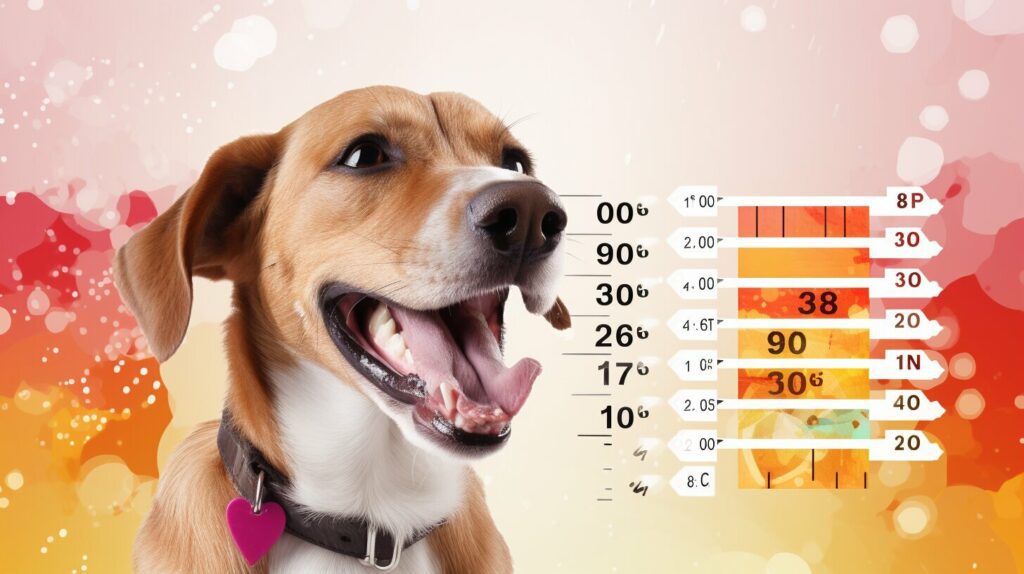As a dog owner, it is important to understand your furry friend’s normal temperature range. Monitoring your pet’s temperature is essential in detecting early signs of potential health issues. In this section, we will explore the normal temperature range for dogs, why it matters, and how to check it.
Key Takeaways:
- The normal temperature range for dogs is between 99.5°F and 102.5°F.
- An ideal body temperature for dogs is 101.3°F
- The canine temperature range can vary depending on breed, age, and activity level.
Why Does the Normal Temperature of Dogs Matter?
As a responsible pet owner, it’s essential to understand the normal temperature of dogs and why it matters for your furry friend’s overall health. Your dog’s body temperature is a critical indicator of their health status and can be an early sign of an underlying health issue.
Monitoring your dog’s body temperature can help you identify health problems before they become severe and potentially life-threatening. Changes in your dog’s temperature can be a sign of infection, inflammation, or other illnesses that require veterinary care.
By regularly checking your dog’s temperature and identifying any deviations from their normal temperature range, you can take proactive measures to keep your pet healthy and prevent more severe problems from developing.
Why Monitoring Dog Health Indicators is Essential
Dogs can’t tell us when they’re not feeling well, making it crucial to monitor your pet’s health indicators closely. By paying attention to changes in your dog’s body temperature, you can identify potential health problems before they become severe.
Other health indicators to watch for include changes in appetite, energy levels, behavior, and bathroom habits. Any significant deviation from your dog’s normal routine could be a sign of an underlying health problem.
Remember that detecting health problems early can help improve treatment outcomes and increase your dog’s chances of recovery. Regular check-ups and monitoring of your dog’s health indicators can help keep your furry friend happy and healthy for years to come.
What is Considered a Normal Temperature for Dogs?
Dogs have a slightly higher body temperature than humans, with a normal range of 100.5°F to 102.5°F (38°C to 39.2°C). This range is known as the canine temperature range, and it may vary slightly depending on the breed, age, size, and activity level of your pet.
The ideal body temperature for dogs is around 101.5°F (38.6°C), which is a good baseline to work from when taking your dog’s temperature. However, it’s important to note that a temperature slightly above or below this range may not necessarily indicate an issue. Several factors can influence variations within this range, such as stress, excitement, and physical activity.
It’s also worth noting that different parts of a dog’s body may have slightly different temperatures. For example, the ears, paws, and nose may be cooler than the rest of the body, while the anus and armpits may be warmer. Therefore, it’s essential to take your dog’s temperature rectally, as this is the most accurate way to measure their body temperature.
How to Check Your Dog’s Temperature?
Checking your dog’s temperature is an important aspect of monitoring their overall health. Here are the steps you need to follow to check your dog’s temperature accurately and safely:
- Choose a thermometer: You can use a rectal or ear thermometer. A rectal thermometer provides more accurate results, but an ear thermometer is less invasive.
- Prepare your dog: Provide a treat or a toy to distract your dog. If using a rectal thermometer, apply lubricant to the tip and hold the thermometer close to your dog to let them smell and see it.
- Take the temperature: If using a rectal thermometer, gently lift your dog’s tail and insert the thermometer about an inch into the rectum. Hold it still until it beeps or for one to two minutes. If using an ear thermometer, insert the tip into the ear canal and hold it still until it beeps or for one to two seconds.
- Record the temperature: Remove the thermometer and record the temperature. The normal temperature of dogs ranges from 99.5°F to 102.5°F. If your dog’s temperature falls outside of this range, consult a veterinarian.
It’s essential to take your dog’s temperature regularly to establish their baseline temperature and to monitor changes over time. Remember to clean the thermometer after each use and dispose of any used covers to prevent the spread of infection.
Signs of Overheating in Dogs
As a pet parent, it’s important to be aware of the signs of overheating in dogs, as it can lead to serious health issues. Dogs regulate their body temperature mainly by panting, and when they become overheated, their body temperature can increase rapidly.
Here are some signs that your dog may be overheating:
- Excessive panting and drooling
- Reddened gums and tongue
- Increased heart rate
- Weakness and dizziness
- Vomiting and diarrhea
If you notice any of these signs, it’s important to take immediate action to prevent your dog from overheating further.
To prevent your dog from overheating in the first place, be mindful of the temperature and limit outdoor activities during the hottest parts of the day. Make sure your pup always has access to fresh water and shade, and never leave them in a parked car on a hot day.
Preventing Overheating in Dogs
To prevent your furry friend from overheating, keep these tips in mind:
- Limit outdoor activities during the hottest parts of the day
- Provide access to water at all times
- Offer a shaded area for your dog to rest and cool down
- Avoid leaving your dog in a parked car
- Consider investing in a cooling coat or mat for your dog
By being aware of the signs of overheating and taking proactive measures to prevent it, you can help your dog stay healthy and happy.
Understanding Dog Fever Symptoms
As a responsible pet owner, it’s important to know what fever symptoms to look out for in your furry friend. Essentially, fever is the body’s natural response to infection or inflammation, with higher temperatures aimed at killing off bacteria or viruses. However, prolonged fever can lead to serious health issues, making it essential to look out for the following symptoms:
- Warm or hot to the touch: One of the most obvious signs of fever is a change in your dog’s body temperature. You can check this using a rectal thermometer, with anything above the normal temperature range indicating a fever.
- Lack of appetite: Fever can cause loss of appetite, which can lead to dehydration and other health issues if not addressed.
- Reduced energy levels: Dogs with fever tend to be lethargic and have reduced activity levels, indicating that all is not well.
- Shivering or panting: Dogs with fever may shiver or pant excessively as their bodies try to regulate temperature.
- Vomiting or diarrhea: These symptoms can occur as a result of infections that cause fever in dogs.
If you observe any of these symptoms, it is essential to seek veterinary assistance promptly. A veterinarian will assess your dog’s condition, diagnose the underlying cause of fever, and recommend appropriate treatment.
Monitoring Your Dog’s Temperature: A Handy Chart
Monitoring your dog’s temperature can be crucial in identifying potential health issues. To help you keep track of your pet’s temperature, consider using a dog temperature chart. This handy chart can assist you in monitoring their temperature levels over time, allowing you to spot any significant changes that may require veterinary attention.
| Temperature (°F) | Condition |
|---|---|
| 99.5 – 101.5 | Normal |
| 100.5 – 102.5 | Mild fever |
| 102.5 – 103.5 | Moderate fever |
| Over 103.5 | High fever |
As a responsible pet owner, it’s essential to monitor your dog’s temperature regularly and record the findings on the chart. By doing so, you can quickly identify any abnormal changes in their temperature, which may be indicative of an underlying illness or infection. It’s crucial to note that temperature ranges can differ depending on the breed and size of the dog, so consult with your veterinarian for breed-specific temperature ranges or any other concerns.
When using the chart, ensure that you take your dog’s temperature at the same time each day to ensure consistency, and avoid factors that could affect their temperature, such as exercise, eating, or drinking.
Remember, using a dog temperature chart is an effective way to monitor your pet’s temperature and spot changes over time. If you notice any significant deviations from their normal temperature range, don’t hesitate to seek veterinary assistance as early diagnosis can save your dog’s life.
Maintaining Your Dog’s Optimal Temperature
As a responsible pet owner, it is essential to ensure that your dog maintains their normal body temperature. Follow these tips to help your furry friend stay comfortable and healthy:
Hydration
Water is essential to regulate your dog’s body temperature, especially during hot months. Ensure that your dog has access to clean and fresh water at all times and encourage them to drink regularly.
Suitable Shelter
Provide your dog with a suitable shelter, particularly during extreme weather conditions. Make sure that the shelter is well-ventilated, dry, and insulated to maintain a comfortable temperature for your pet.
Appropriate Clothing
Dress your dog appropriately in colder weather to prevent their body temperature from dropping. Consider investing in dog jackets, sweaters, or booties to keep them warm and comfortable.
Exercise
Regular exercise is crucial to maintain your dog’s overall health, but ensure that you don’t overdo it during hot or cold weather. Avoid exercising your pet during peak temperatures of the day, and don’t let them stay outside for extended periods during extreme weather conditions.
Regular Temperature Checks
Keep a close eye on your dog’s temperature by monitoring it regularly. You can use a digital thermometer to take your pet’s temperature rectally. The ideal body temperature for dogs is 100.5°F to 102.5°F; any significant deviations from this range may indicate underlying health issues.
By following these tips, you can help ensure your dog maintains their optimal body temperature, promoting their overall health and well-being.
Recognizing Abnormal Temperature Changes in Dogs
As a responsible dog owner, it is crucial to monitor your pet’s temperature regularly. This will help you establish their usual baseline temperature and identify any abnormal changes that may indicate underlying health issues.
The following are some common indications of abnormal temperature changes in dogs:
- Excessively high temperatures (hyperthermia) above 103°F or low temperatures (hypothermia) below 99°F
- Shivering or trembling
- Lethargy or weakness
- Loss of appetite
- Vomiting or diarrhea
- Rapid breathing or panting
- Changes in behavior or mood
If you notice any of these symptoms, it is essential to seek veterinary advice immediately. Remember, these signs may not always indicate a problem with your dog’s temperature, but they could still signal a severe health issue. So, do not take any chances and seek professional help.
It is also important to note that if you live in a region with extreme weather conditions, such as hot summers or freezing winters, your dog may be more susceptible to temperature-related illnesses. So, make sure you take precautions, such as proper hydration, suitable shelter, and appropriate clothing, to keep your furry companion healthy and comfortable.
Conclusion
Being aware of your dog’s normal temperature range and monitoring their temperature levels regularly is crucial for maintaining their overall health. By understanding the signs of overheating, fever, and abnormal temperature changes, you can take proactive measures to prevent serious health issues from developing.
Remember, always seek veterinary assistance if your dog demonstrates significant deviations from their normal temperature range. Use the handy temperature chart to track your dog’s temperature levels over time and take steps to maintain their optimal body temperature through hydration, adequate shelter, and appropriate clothing in extreme temperatures.
Your furry companion relies on you to keep them healthy and happy, so make sure you prioritize their well-being by keeping an eye on their temperature and reacting proactively to any deviations.
FAQ
Q: What is considered a normal temperature range for dogs?
A: The normal temperature range for dogs is typically between 99.5°F and 102.5°F (37.5°C and 39.2°C).
Q: Why is it important to monitor your dog’s temperature?
A: Monitoring your dog’s temperature can help detect any underlying health issues and serve as a vital indicator of their overall well-being.
Q: What factors can affect a dog’s temperature levels?
A: Factors such as age, activity level, environmental conditions, and medical conditions can all influence a dog’s temperature levels.
Q: How can I check my dog’s temperature at home?
A: There are several methods to check your dog’s temperature at home, including using a rectal thermometer, ear thermometer, or infrared thermometer. It’s important to follow proper instructions and ensure the safety and comfort of your dog during the process.
Q: What are the signs of overheating in dogs?
A: Signs of overheating in dogs can include excessive panting, drooling, rapid breathing, elevated body temperature, weakness, and collapse. It’s important to take immediate action to cool down your dog if you suspect overheating.
Q: What are the symptoms of fever in dogs?
A: Symptoms of fever in dogs can include a high body temperature, loss of appetite, lethargy, shivering, and nasal discharge. If you suspect your dog has a fever, it’s recommended to consult a veterinarian for proper diagnosis and treatment.
Q: Is there a handy chart to monitor my dog’s temperature?
A: Yes, there are handy dog temperature charts available that can assist you in monitoring your dog’s temperature levels over time. These charts often indicate the normal temperature range and help you track any deviations.
Q: How can I help my dog maintain their optimal temperature?
A: You can help your dog maintain their optimal temperature by ensuring they have access to fresh water, providing appropriate shelter in extreme temperatures, and avoiding excessive exercise during hot weather. In colder conditions, consider using appropriate clothing to keep them warm.
Q: What should I do if I observe abnormal temperature changes in my dog?
A: If you observe abnormal temperature changes in your dog, it’s important to seek veterinary advice. Significant deviations from their normal temperature can indicate underlying health issues that require professional attention.



